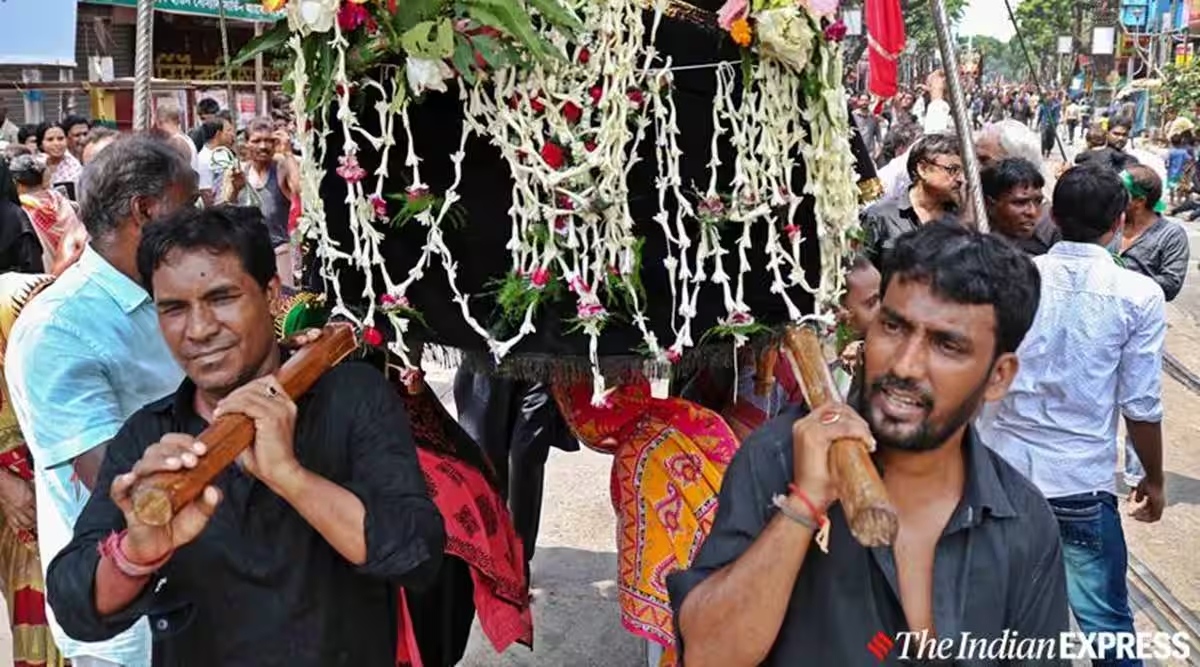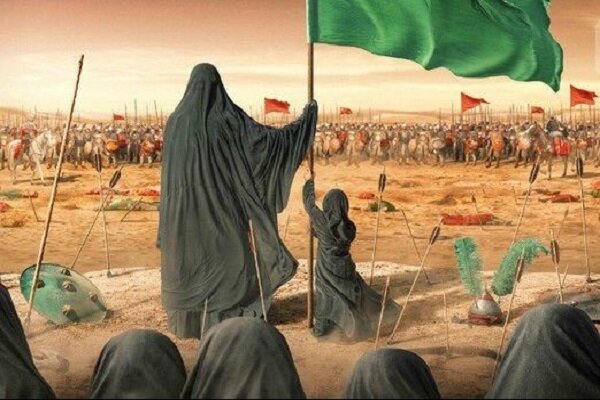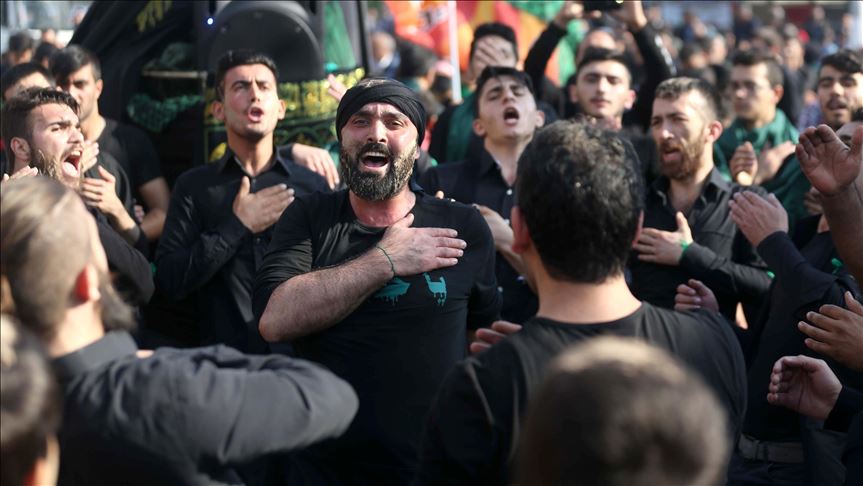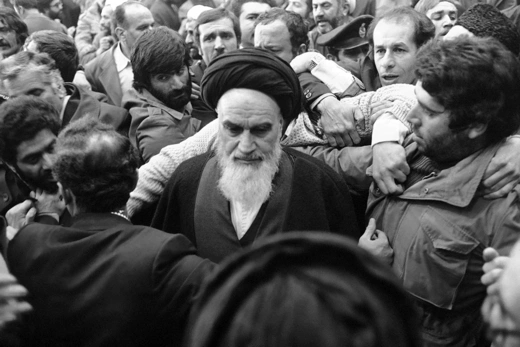S
Shruti Dasgupta
Guest
The nearly 200 million strong second-largest religious community in India observes Muharram today. The 15% Indian Muslim community, which is the 3rd largest Islamic population, observes Muharram during the first month of the Islamic lunar calendar or the month of ‘Allah’. After a nearly 30-year gap, India’s Kashmiri Shia community took out a procession at Srinagar to mark this day.

PC The Indian Express
Muharram holds profound significance for Muslims not just in India but worldwide as well. Muslims mark this month with various observances, most notably the commemoration of the martyrdom of Imam Hussain, the grandson of Prophet Muhammad. The events of Muharram hold great historical and religious importance and are observed by different sects of Muslims in distinct ways.

PC Mehr News Agency
The history of Muharram is intertwined with the tragic event of Karbala, which occurred in 680 AD. Imam Hussain, a revered figure in Islam, refused to pledge allegiance to the Umayyad Caliph, Yazid. Imam Hussain, along with his family members and loyal companions, faced oppression and brutality at the hands of Yazid’s army.
On the 10th day of Muharram, known as Ashura, the Battle of Karbala took place in present-day Iraq. Imam Hussain and his small group of supporters stood against a much larger enemy force. Hussain and his followers were tragically martyred at the hands of 4000 men of Yazid’s army. Thus, Islamic history marks this day Muharram. Moreover, the Shia community marks this day as a poignant reminder of the struggle for justice, truth, and righteousness in the face of tyranny.

PC Anadolu Agency
For Shia Muslims, Muharram is a period of intense mourning and grief. They participate in processions and majlis or religious gatherings. They narrate the events of Karbala in these gatherings. Shias mark this day by fasting, prayers, and recounting the heroic sacrifice of Imam Hussain.

PC The Channel 46
Sunni Muslims also observe Muharram, but their approach differs. While some of them acknowledge the significance of Ashura, most do not engage in the same level of mourning as Shia Muslims. Instead, Sunni Muslims use this whole month for spiritual reflection, seeking forgiveness, and performing acts of charity. They celebrate this month as the month of ‘Allah’.

PC Depositphotos
Sufi Muslims view Muharram as a time for introspection and spiritual growth. They try to focus on the internal aspects of faith, emphasizing love, compassion, and unity among all Muslims. Sufi gatherings during Muharram may involve music, poetry, and spiritual teachings.
There are certain differences and conflicts between different sects of Muslims regarding the observance of Muharram, especially concerning the way the events of Karbala are commemorated. The observance of Muharram is also influenced by local customs and traditions. Thus, some regions experience tensions between the Shia and Sunni communities. The historical and political factors in various parts of the world lead to conflicting approaches to commemorating Muharram.

PC The New India Express
The major conflict related to Muharram is between Shia and Sunni Muslim sects. Shia Muslims have a distinct and more intense way of observing Muharram, including mourning processions, self-flagellation or Tazia, and reenactments of the events of Karbala. They passionately mourn the martyrdom of Imam Hussain and his followers, expressing their grief through rituals like ‘matam’ and ‘zanjeer zani’ or hitting oneself with chains. Most Sunni scholars and communities criticize these practices as excessive and inappropriate. They consider these emotions and their rituals to be outside the bounds of traditional Islamic practices. This is the primary cause of tensions between the two Muslim sects.
The two sects have varying perspectives on the historical events of Karbala. The Shia Muslims hold Imam Hussain’s stand against the Umayyad Caliph as a righteous struggle against injustice and tyranny. The Sunni scholars emphasize the need to avoid sectarian conflict and focus on the spiritual aspects of the month rather than specific historical events. They deny the Shia aspect of making a martyr of a man; they only mark this day as a day of introspection in the faith of Islam.

PC Council of Foreign Relations
Unfortunately, in some regions, tensions during Muharram have led to violent clashes between different sects of Islam. In certain instances, the differences in observance have resulted in communal strife and sectarian violence. Thereby, undermining the true spirit of unity and remembrance that Muharram should promote.
In some countries, the governments impose restrictions on certain Muharram-related activities; especially those deemed to be provocative or potentially incite sectarian tensions. These regulations aim to maintain social harmony but can sometimes lead to grievances among certain communities.
In some cases, political leaders may exploit sectarian divisions among Muslims. During Muharram, they advance their own agendas by encouraging heightened tensions and polarization among different communities. In India, the division is not only visible among the Muslim sects but also with other religions of the country. The tazia processions have caused traffic jams and religious tensions.
While Muharram is a sacred and important month for Muslims worldwide, differences in observance and interpretations of historical events have led to some conflicts between different sects. Iran, Iraq, Pakistan, Bahrain, and Yemen continue to face tensions on this day of religious significance among the sects of Islam. Even in India, the Shia community faces suppression by the Sunni sect. This is most evident in the case of the Kashmiri Shia community. The BJP administration has allowed the Shia community to mark Muharram by allowing a procession to pass through Lal Chowk in Srinagar after 34 years in the state. Consequently, this year marks safety for all sects of Islam in India under the BJP government.
The ‘peacefuls’ find difficulty in observing days of significance among themselves. Therefore, it is only natural that they find celebrations of other religions a cause of dispute. While Islamists preach harmony to other religions, they are unable to bridge the gaps and promote understanding among different Muslim sects during this significant month around the world. Thus, detractors of India and PM Modi should take note of the tolerance of Hindus towards other religions, as evident in the Kashmiri Shia procession. India under BJP governance is not divided by dots!!!
The post Muharram: Significance, Sects, and Tensions Among Muslims Worldwide appeared first on The Jaipur Dialogues.
Continue reading...

PC The Indian Express
Muharram holds profound significance for Muslims not just in India but worldwide as well. Muslims mark this month with various observances, most notably the commemoration of the martyrdom of Imam Hussain, the grandson of Prophet Muhammad. The events of Muharram hold great historical and religious importance and are observed by different sects of Muslims in distinct ways.
The Legend Behind Muharram

PC Mehr News Agency
The history of Muharram is intertwined with the tragic event of Karbala, which occurred in 680 AD. Imam Hussain, a revered figure in Islam, refused to pledge allegiance to the Umayyad Caliph, Yazid. Imam Hussain, along with his family members and loyal companions, faced oppression and brutality at the hands of Yazid’s army.
On the 10th day of Muharram, known as Ashura, the Battle of Karbala took place in present-day Iraq. Imam Hussain and his small group of supporters stood against a much larger enemy force. Hussain and his followers were tragically martyred at the hands of 4000 men of Yazid’s army. Thus, Islamic history marks this day Muharram. Moreover, the Shia community marks this day as a poignant reminder of the struggle for justice, truth, and righteousness in the face of tyranny.
How is Muharram observed by Different Muslim Sects?
Shia Muslims

PC Anadolu Agency
For Shia Muslims, Muharram is a period of intense mourning and grief. They participate in processions and majlis or religious gatherings. They narrate the events of Karbala in these gatherings. Shias mark this day by fasting, prayers, and recounting the heroic sacrifice of Imam Hussain.
Majlis often includes recitations of elegies, known as Nohas and Marsiyas, expressing sorrow and devotion to Imam Hussain. Usually, they wear black clothes to mourn their heroes and mark their solemnity.
Sunni Muslims

PC The Channel 46
Sunni Muslims also observe Muharram, but their approach differs. While some of them acknowledge the significance of Ashura, most do not engage in the same level of mourning as Shia Muslims. Instead, Sunni Muslims use this whole month for spiritual reflection, seeking forgiveness, and performing acts of charity. They celebrate this month as the month of ‘Allah’.
Sufi Muslims

PC Depositphotos
Sufi Muslims view Muharram as a time for introspection and spiritual growth. They try to focus on the internal aspects of faith, emphasizing love, compassion, and unity among all Muslims. Sufi gatherings during Muharram may involve music, poetry, and spiritual teachings.
The Shia-Sunni Divide: Conflicts Among Muslim Sects
There are certain differences and conflicts between different sects of Muslims regarding the observance of Muharram, especially concerning the way the events of Karbala are commemorated. The observance of Muharram is also influenced by local customs and traditions. Thus, some regions experience tensions between the Shia and Sunni communities. The historical and political factors in various parts of the world lead to conflicting approaches to commemorating Muharram.

PC The New India Express
The major conflict related to Muharram is between Shia and Sunni Muslim sects. Shia Muslims have a distinct and more intense way of observing Muharram, including mourning processions, self-flagellation or Tazia, and reenactments of the events of Karbala. They passionately mourn the martyrdom of Imam Hussain and his followers, expressing their grief through rituals like ‘matam’ and ‘zanjeer zani’ or hitting oneself with chains. Most Sunni scholars and communities criticize these practices as excessive and inappropriate. They consider these emotions and their rituals to be outside the bounds of traditional Islamic practices. This is the primary cause of tensions between the two Muslim sects.
The two sects have varying perspectives on the historical events of Karbala. The Shia Muslims hold Imam Hussain’s stand against the Umayyad Caliph as a righteous struggle against injustice and tyranny. The Sunni scholars emphasize the need to avoid sectarian conflict and focus on the spiritual aspects of the month rather than specific historical events. They deny the Shia aspect of making a martyr of a man; they only mark this day as a day of introspection in the faith of Islam.
Shia-Sunni Tensions Around the World

PC Council of Foreign Relations
Unfortunately, in some regions, tensions during Muharram have led to violent clashes between different sects of Islam. In certain instances, the differences in observance have resulted in communal strife and sectarian violence. Thereby, undermining the true spirit of unity and remembrance that Muharram should promote.
In some countries, the governments impose restrictions on certain Muharram-related activities; especially those deemed to be provocative or potentially incite sectarian tensions. These regulations aim to maintain social harmony but can sometimes lead to grievances among certain communities.
In some cases, political leaders may exploit sectarian divisions among Muslims. During Muharram, they advance their own agendas by encouraging heightened tensions and polarization among different communities. In India, the division is not only visible among the Muslim sects but also with other religions of the country. The tazia processions have caused traffic jams and religious tensions.
Conclusion
While Muharram is a sacred and important month for Muslims worldwide, differences in observance and interpretations of historical events have led to some conflicts between different sects. Iran, Iraq, Pakistan, Bahrain, and Yemen continue to face tensions on this day of religious significance among the sects of Islam. Even in India, the Shia community faces suppression by the Sunni sect. This is most evident in the case of the Kashmiri Shia community. The BJP administration has allowed the Shia community to mark Muharram by allowing a procession to pass through Lal Chowk in Srinagar after 34 years in the state. Consequently, this year marks safety for all sects of Islam in India under the BJP government.
The ‘peacefuls’ find difficulty in observing days of significance among themselves. Therefore, it is only natural that they find celebrations of other religions a cause of dispute. While Islamists preach harmony to other religions, they are unable to bridge the gaps and promote understanding among different Muslim sects during this significant month around the world. Thus, detractors of India and PM Modi should take note of the tolerance of Hindus towards other religions, as evident in the Kashmiri Shia procession. India under BJP governance is not divided by dots!!!
The post Muharram: Significance, Sects, and Tensions Among Muslims Worldwide appeared first on The Jaipur Dialogues.
Continue reading...
